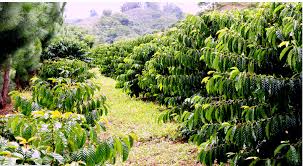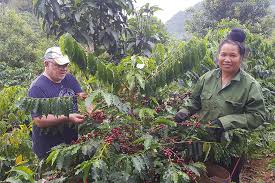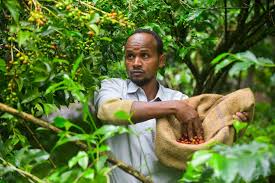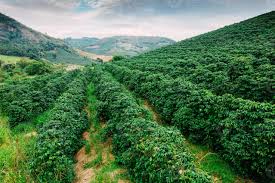Planning the Arabica Coffee farm establishment begins with designing the farm layout where areas for coffee gardens, road networks, drying yards, farm houses for family and workers, and a coffee store are properly arranged.
Land preparation then commences with the objectives of facilitating maximum water infiltration, minimizing soil movement, ensuring safe disposal of surplus water, and simplifying irrigation works. Once the land is cleared and coffee is planted, attention shifts to implementing good management practices.
Poor field management significantly contributes to low productivity in coffee; therefore, appropriate investments in recommended best field management practices for maximum productivity are advised.
The unit to be planted with coffee must be prepared at least one year before the coffee seedlings are planted out. There are distinct steps to follow for good coffee establishment:
1. Plan the Coffee Farm Layout for Optimal Production
This activity is carried out in accordance with the guidelines presented in Annex 3. The careful design of the farm layout ensures that coffee gardens, support facilities, and infrastructure are optimally arranged to support efficient farm operations and sustainable agricultural practices.
2. Clear the Site for Safe and Effective Coffee Planting
Coffee establishes properly only on clean, well-prepared land. The land is prepared during the dry season. If the land is under forest, it must be cleared thoroughly, including the removal of tree stumps and their roots; however, some selected trees are retained for shade.
The roots of old tree stumps are frequently a source of infection to the young coffee by the fungus Armillaria. This disease can be avoided by ring-barking the forest trees at least one year before they are felled and cleared. Some important practices for land preparation include:
1. Leaving some mature trees for shade at a spacing of 20 x 20 m to provide adequate cover while avoiding competition for water and nutrients.
2. Completely eradicating couch grass (Lumbugu) before land ploughing by digging, handpicking with a hand hoe, or applying herbicides such as Glyphosate (Roundup) prior to planting.
3. Clearing arable land of all previous crops to prepare for planting coffee.
4. Carrying out deep ploughing as an effective method to rejuvenate the soil.
5. Planting banana trees for extra shade if required.
6. Planting ground covers to avoid soil erosion.
7. Establishing terraces on sloped terrain.
Read Also: How to Grow, Use and Care for Whitetinge Sedge Grass (Carex albicans)
3. Plant Windbreakers for Crop Protection and Environmental Balance

Windbreakers, as illustrated in Figures 4(a) and 4(b), are usually located along the boundaries of the coffee field and must be established before planting the coffee seedlings. Recommended shade trees for Arabica Coffee that may be planted as windbreakers include
Albizia, Coriaria, Ficus mucuso, Cordia Africana, avocados, jackfruit, and mangoes, preferably planted at a spacing of 60 x 60 ft. For sloping land, the spacing between windbreakers is closer. Windbreakers are useful because they help to:
1. Reduce the speed of wind and evapotranspiration.
2. Accelerate the growth of young coffee trees.
3. Lower the maximum temperature or raise the minimum temperatures within the coffee, especially at high altitudes.
4. Conserve soil moisture and reduce erosion.
5. Increase biodiversity.
4. Mark Out the Rows for Precise Coffee Planting
Marking rows for planting coffee is crucial in establishing a coffee farm. The recommended row direction follows the contour lines. Arabica Coffee varieties SL14, SL28, KP423, and KP162 are planted at a spacing of 2.4 m x 2.4 m (8 ft x 8 ft), resulting in about 680 coffee trees per acre or 1,700 trees per hectare.
On sloping terrain, terraces are first established as illustrated in Figure 7 before marking the planting holes. When the land slope exceeds 15%, contour planting must be undertaken. A simple wooden A-frame structure measuring 5 ft (1.5 m) high with legs 4 ft (1.2 m) apart is constructed.
The horizontal support crosspiece is marked at the central point. A string with a weight (stone or metal object) is attached at the apex of the A-frame and allowed to hang freely, similar to a pendulum.
Starting at the bottom of the slope, the A-frame is moved across the slope by rotating it from one leg to the other. A marker is placed at each point on the ground where the pendulum lines up with the centre mark on the crosspiece, indicating the planting hole for each plant in that row or along that contour.
The process is repeated for the desired length of the contour line, and the next contour line is located at 8 ft (2.4 m) upslope or downslope from the first row. The same marking procedure continues until the entire field is marked.
Water conservation measures such as contour trenches, contour terraces, vegetative barriers, bands, grass strips, and cut-off drains are implemented to avoid soil, water, and nutrient loss.
5. Establish Shade Trees for Climate Regulation and Enhanced Biodiversity

Given the current effects of climate change, shade trees play an important role in Arabica Coffee farming by mitigating excessive temperatures and heat stress, which are responsible for flower and fruit abortion. Shade trees must be established at least one year before planting the coffee seedlings.
They must not be planted simultaneously or after the coffee seedlings. Shade trees are planted in rows throughout the coffee garden; care is taken to avoid excessive shade tree density, which may lead to competition with coffee for moisture and nutrients.
The recommended spacing for shade trees is approximately 20 m to 40 m apart. In warmer areas such as mid-northern Uganda, shade tree spacing may be reduced to 10 m–15 m. Once established, proper pruning is necessary to ensure adequate aeration and sunlight in the field.
This practice prevents high relative humidity that can result from excessive shadow, a condition that favors disease and pest development such as coffee leaf rust and stem borers.
Read Also: How to Grow, Use and Care for Whitegrass (Leersia virginica)
Shade Tree Species to Avoid for Coffee Production

When planting shade trees, it is important to avoid tree species with the following characteristics:
1. Trees that serve as alternate hosts to Arabica Coffee pests, such as Avocado and Albizia chinensis.
2. Hardwood trees that attract pit sawyers, such as Grevillea robusta and Maesopsis eminii (Musizi).
3. Trees that require a long time to grow, such as Milicia excelsa (Mvule).
4. Trees that produce only conical shade, such as Eucalyptus and jackfruit trees.
5. Trees with leaves that take a long time to decompose, such as Pine, jackfruit, and avocado.
6. Trees that produce thorns, such as Erythrina abyssinica (Ejjirikiti).
7. Poisonous trees.
Advantages of Shade Trees
1. Protect coffee bushes from heavy rainstorms and hailstorms.
2. Reduce wind speed and soil erosion by acting as windbreakers.
3. Protect coffee plants from high solar radiation and limit evapotranspiration.
4. Limit weed growth.
5. Provide organic matter to the soil.
6. Reduce plant metabolism, promoting more regular flowering.
7. Increase biodiversity by supporting higher populations of birds (predators of coffee pests) and pollinators, thereby improving fruit formation.
8. Stabilize the soil by reducing erosion and water runoff.
9. Meet organic coffee growing requirements.
10. Slow bean ripening, which improves bean density and cup flavor.
11. Enhance nutrient utilization by capturing leached nutrients beyond the coffee tree’s reach and returning them to the topsoil through falling leaves that act as mulch.
12. In the case of leguminous trees such as Caliandra spp, fix atmospheric nitrogen to restore soil fertility and structure.
13. Provide foliage for domestic animals and firewood when pruned for shade regulation.
Disadvantages of Shade Trees
1. Compete with coffee for nutrients and water.
2. Require regular pruning and thinning, which is labor intensive.
3. Decrease photosynthetic activity and cause internode elongation, resulting in lower yields.
4. Increase the risk of coffee leaf rust, particularly in coffee with a high shade tree cover.
Do you have any questions, suggestions, or contributions? If so, please feel free to use the comment box below to share your thoughts. We also encourage you to kindly share this information with others who might benefit from it. Since we can’t reach everyone at once, we truly appreciate your help in spreading the word. Thank you so much for your support and for sharing!

